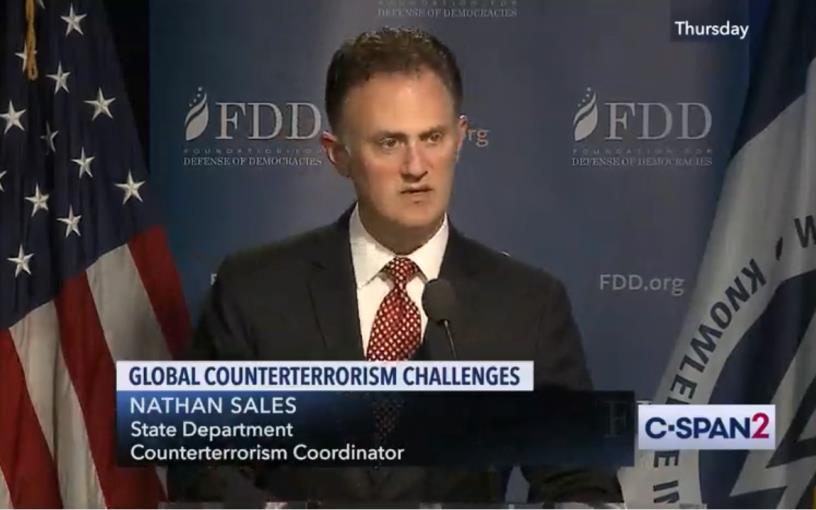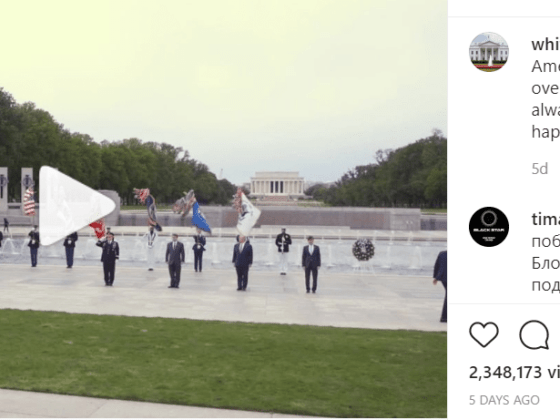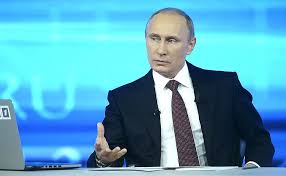(PONARS Eurasia Policy Memo) On April 6, 2020, the U.S. State Department designated the Russian Imperial Movement (RIM) as a terrorist organization and placed its leaders on its list of Specially Designated Global Terrorists. This unprecedented move—the first time in history the State Department has deployed tools reserved for jihadist groups against a white supremacist organization—comes at a time of rising right-wing extremism and violence in the United States and around the globe as well as the internationalization of white supremacist movements.
While the RIM’s ongoing paramilitary training and support for violent action outside of Russia is a case for real concern, the impact of labeling it as a terrorist entity will be limited at best. The RIM’s American connections are thin, its membership is small, and its global reach is paltry compared to the shared influences of white supremacists in North America and Europe. Overstating the RIM’s connection to the Kremlin and Russia’s ability to incite violence via the U.S. far right obscures the homegrown nature of the U.S. white supremacist movement, which has been emboldened by the normalization of hate speech and the spread of racist and xenophobic views in mainstream politics. As the rapidly growing and diversifying far right continues connecting across borders, it is imperative to better understand common ties, influencers, and networking platforms in order to develop comprehensive measures to counter the proliferation of violence and hate.
The Rise of the Russian Imperial Movement
The Russian Imperial Movement is an ultra-nationalist paramilitary organization that seeks to restore an autocratic monarchy and build a mono-ethnic state in Russia. It belongs to a broader milieu of far-right monarchist groups that revere Russia’s imperial past, embrace anti-Semitic ideas, and romanticize revolutionary violence. The RIM was founded in 2002 as part of the Russian right-wing tide energized by the socio-economic turbulence of the 1990s, increasing immigration, and growing restrictions on political dissent.
The RIM was an obscure fringe movement until two prominent events propelled it into national and global notoriety. In 2014, following its annexation of Crimea, Russia began a protracted military intervention in the Donbas region of Ukraine. Many Russian far-right groups began sending volunteer fighters to the region, which soon became an epicenter for global far-right militancy. The RIM gained its visibility by forming two brigades of volunteers trained in hand-to-hand combat and martial arts, both of which were sent to the line of conflict in the summer of 2014. In more recent years, members of the paramilitary wing of the RIM appeared as mercenaries in the Middle East and North Africa.
The further transnationalization of the RIM occurred following its alliance with “Rodina” (Motherland), an ultra-nationalist coalition created by Dmitry Rogozin and other far-rightists. Together with Rodina, the RIM became a co-founder of the World National-Conservative Movement (WNCM), a network of over fifty European and Russian extreme right groups united in their rejection of ideas of multiculturalism, liberalism, and tolerance. The WNCM organizers also envisioned that the members of the movement would share tactical skills and training. The RIM used the opportunity to promote its ongoing military-style training camps to far-right counterparts in Europe and beyond.
One of the first organizations that received an invitation to join the WNCM was the Swedish fascist group Nordic Resistance. In September 2015, the leadership of the RIM traveled to Sweden to speak at a Nordic Resistance event and provided modest financial assistance for efforts to build a political party espousing white supremacist ideas. The following year, two former members of the Nordic group took part in eleven days of paramilitary training in St. Petersburg organized by the RIM. That training “was a key step in [their] radicalization,” according to the prosecutor handling a case involving the bombing of a refugee center in Gothenburg, Sweden. The two perpetrators “learned to manufacture the bombs used in Gothenburg” at the RIM-run camp. The training and subsequent terrorist attack in Sweden were cited as evidence by the U.S. Department of State that RIM should be designated as a terrorist organization.
The RIM’s Limited Connections to the U.S. Far Right
Although the RIM has a well-documented record of networking and sponsorship of far-right activities throughout Europe, its presence in North America has been negligible. The tenuous ties between the RIM and America’s far-right over the past few years centered on only a handful of interactions between RIM members and U.S. far-right representatives. In early 2015, Jared Taylor, the editor of American Renaissance and founder of the New Century Foundation, and Sam Dickson, a former Klan lawyer from Atlanta, traveled across Europe forging ties with other prominent faces of white supremacism in a gathering organized by the RIM. Around the same time, Matthew Heimbach, who became the “most important white supremacist” of 2016, according to ThinkProgress, launched a sustained effort at internationalizing his Traditionalist Worker Party, a neo-Nazi group created in advance of the 2016 U.S. elections. Heimbach made multiple trips to Europe building relationships with like-minded groups, individuals, and movements, including with RIM representatives. Acting as a bridge between the Russian and American white supremacists, Heimbach attempted to attend the WNCM conference in Russia organized by Rodina and its Russian counterparts.
It was probably Heimbach, one of the organizers of the August 12, 2017, “Unite the Right” white supremacist rally in Charlottesville, Virginia, who shared information about the event with the RIM. According to unsubstantiated intelligence reports, the RIM reached out to the rally’s organizers with the offer of a paramilitary course. Both RIM representatives and U.S. white supremacist leaders—Richard Spencer, Jason Kessler, and Eli Mosley—denied receiving or accepting the training offer. In the fall of 2017, one of the RIM’s members, Stanislav Shevchuk, visited the United States on the invitation of Matthew Heimbach. The two traveled to historic sites in Washington, DC, Virginia, and Pennsylvania, and posed in front of the White House hoisting a Russian imperial flag.
The RIM’s radical views, efforts to spread their ultra-nationalist and racist ideas, and ongoing offers of paramilitary-style training to white supremacists around the world are undeniably dangerous. It is not convincing, however, that the RIM poses greater risk to U.S. society than other far-right groups. For example, U.S. politicians have called for the terrorist designation to be placed on the Nordic Resistance Movement. It is a “threat, particularly to Europe,” according to the 2018 National Strategy for Counterterrorism of the United States, “because of its propensity to use violence and its intent to destabilize societies.” Another candidate for the list is The Base, a neo-Nazi organization seeking to “accelerate the downfall of the United States government, incite a race war, and establish a white ethnostate.” This group has actively sought to recruit American citizens online and is tied to Russian intelligence. Its U.S. founder currently resides in Russia, and the group has held paramilitary training sessions in the Pacific Northwest.
Some opine that the choice of the RIM for terrorist designation has precisely to do with its lack of significant U.S. ties, because a group with such connections could present a major First Amendment challenge. Indeed, the RIM’s links to the U.S. far-right movement have long been impaired. Heimbach was arrested in 2018 for assaulting his father-in-law and a co-founder of the Traditionalist Worker Party, which was disbanded the same year. The organizers of the violent rally in Charlottesville went quiet following the public outcry, exclusion from many websites and platforms, and legal repercussions in the wake of the rally.
It is also likely that the designation of the RIM has to do with it being Russian. The designation comports with the narrative of the Kremlin’s financial sponsorship, logistical assistance, and ideological congruence with the far right exploited by the Putin regime for meddling in Western politics and fracturing political coalitions. If the United States ever decides to extend its Tehran policy to Moscow and designate Russia as a state sponsor of terrorism, the RIM’s terrorist designation is a necessary step in this direction. It also hits at the heart of many white nationalists’ admiration for Russia’s authoritarian ruler and his overseas policies.
Do Not Obscure the Transnationalization Sources of the Far Right
Although Russia’s financial and organizational support of far-right movements is well-documented in investigative journalism and a handful of academic studies, the depth and real impacts of the links between Moscow and white nationalists in the West are still poorly understood. The so-called “mutual affection” between the Kremlin and far-right groups in the West should not obscure the fact that Russian meddling in Western politics is ideologically fluid. It can extend across the entire political spectrum and command the support of varying segments of civil society and the business world.
The Kremlin’s toying with the far right has been a matter of expediency and regime insecurity. A wave of demonstrations against President Vladimir Putin’s return to power in 2011-12, organized by Russia’s traditional and non-systemic opposition (including nationalist groups), was a trigger for Putin’s devious conservative pivot. The two positions shared by the diverse, ultra-right wing of Russia’s political spectrum were a virulently anti-migrant agenda and unambiguous opposition to the regime. Ethnic riots, followed by anti-government and anti-immigrant demonstrations, prompted a crackdown on the far right in Russia. While the nationalist groups loyal to the regime survived, most of the leaders of the far-right movements that propagated ideas similar to their Western counterparts ended up in jail or self-imposed exile.
In the wake of Crimea’s annexation, Kremlin ideologues again coopted the ultra-nationalist, patriotic, and monarchist groups’ support for the idea of “Novorossiya” and mobilizing volunteers for the battlefield in Donbas. As the Kremlin’s priorities changed and the Russian government dropped its talk of “Novorossiya,” it abandoned the many nationalist organizations it had alliances with, indicating that they had always been marriages of convenience.
In addition, both European and American far-right organizations have acted autonomously of Russia’s far-right groups, pursuing their own plans and making informed and independent decisions based on their goals and intentions. The message that the Kremlin and Russia’s far right have been actively co-opting and manipulating them conceals the dangerous reality that American and European white supremacists are actively seeking to export their messages and activities across borders. Russian far-right groups have been receptive to anti-Semitic ideas arriving from the West. Lyndon LaRouche, a controversial American leader of a sect espousing anti-Semitic views, made numerous visits to Russia in the 1990s, holding meetings with parliamentarians, scientists, and representatives of civil society. More recently, David Duke, a neo-Nazi, longtime Klan leader, and an international spokesman for Holocaust deniers, spent five years in Russia writing and selling his books and supporting supremacist conferences, often as the only representative from the United States. Duke also brought other American white supremacists to Moscow, including Preston Wiginton, a white supremacist from Texas who became a key “white power” activist in Russia. Having found a receptive audience in Russia, on balance, American white supremacists have been more active in spreading their ideology among the like-minded Russian groups than has been the Russian far right in spreading its ideas in the United States.
Conclusion
The internationalization and weaponization of far-right movements are significant and dangerous phenomena that must be addressed, and the threat of far-right violence must be actively countered. However, for terrorist designations of white supremacist groups to be effective, they must be part of a comprehensive package of measures designed to confront the rise of far-right extremism.
To begin with, the U.S. government must pursue systematic data collection and research into white supremacy and its international connections. While there are multiple non-governmental groups monitoring far-right extremist violence, there are few government-published statistics for keeping track of the scale and direction of the threat, as well as the ideologues, ideologies, and sponsors that drive it. The National Counterterrorism Center and the State Department’s Global Engagement Center could be empowered to conduct analyses regarding the nature and direction of supremacist threats. The Department of State should publish an explicit set of guidelines for designating white supremacist groups as terrorist organizations and apply close scrutiny of the ideological, financial, and organizational connections between U.S. and foreign far-right activists and organizations. Finally, robust partnerships with other governments, non-governmental organizations, and private sector organizations are essential for creating safe spaces in communities and online while respecting free speech and the right to peacefully protest.
Mariya Omelicheva is Professor of National Security Strategy at the National War College. The views expressed in this paper are those of the author and are not an official policy or position of the National Defense University, the Department of Defense, or the U.S. Government.
[PDF]
Homepage image credit.
Memo #: 653
Series: 2











